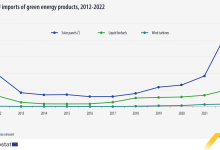Who Is Guilty for the High Energy Prices?
Iulian Harpa is Managing Partner of HiM Public Affairs, a consulting firm operating mainly in the energy sector
Anyone who hasn’t experienced the oil crisis of the 1970s or who has believed in a speedy recovery of economy, aggressively stimulated through capital injections after an unprecedented lock-down, seems to have miscalculated their strategy.
If we don’t want to risk the ‘hallo effect’ symptom, we should all assume that energy prices will never return to pre-crisis levels, if we want to keep a planet that can breathe for future generations.
My mistake and… lesson learned!
After the liberalization of the Romanian energy market, I decided based on a piece of research to change the gas supplier which had a good history, an impressive number of subscribers and an invincible price. In October 2021 I was notified that the supplier had ceased to operate in the gas market and thus, I was assigned to a Supplier of last resort (FUI). I have implicitly assumed that I can pay – if I exceed the consumption ceiling – a price several times higher than the price already doubled! It was not the case, but for me, it was an alarm signal received from the wild market in Romania, where suppliers and producers need a solid strategy of long-term contracts and regulators to properly evaluate suppliers and not to intervene in the market permanently retroactive!
What factors caused the price increase?
There are several factors that underlie these crazy prices which are difficult to be managed by any manager, in any industry and even or any household consumer. For example, gas prices have increased 5 times in the last year in Europe and 2.5 times in Asia and America.
Classic factors – already analysed and assumed:
- The pandemic crisis and the lock-down that caused anomalies such as negative selling prices of the oil barrel due to lack of demand and storage space;
- Too fast recovery of economies, stimulated by governments and international banks with significant injection of capital.
- Increased prices for CO2 certificates, almost 3 times in the last year!
- Very low reserves of gas stocks, still at historic level in Europe;
- Liberalization of energy markets in Romania, without ensuring the implementation of functional mechanisms to govern the successful transition to a competitive system;
- The lack of investments in new production capacities, which in the case of Romania, costs us a lot – being net energy importers in the last 2 years!
Factors identified in recent months
- Much lower gas supplies in recent months from Russia (we know that currently 41% of total gas imports to Europe are provided by Gazprom);
- Reducing the production of energy from fossil fuels, without balancing with an increase equivalent to energy from renewable sources;
- Short-term, speculative contracting options, to the detriment of long-term contracts between manufacturers and suppliers. Each of them trying to take advantage of the opportunities of market for the next day (PZU);
Newcomers
- The prices of renewable energy producers were aligned (throughout the producer-transporter-distributor-supplier chain) with the high prices of fossil fuel energy producers;
- The increase in the price of oil in the last period, which, implicitly, immediately attracts the increase of gas prices;
- Europe’s competition with Asia for LPG supply.
- Recent geopolitical risks that bring a lack of predictability in the market.
Anomalies in the global energy market
Although we are trying to understand all this combination of factors called ‘perfect storm’, I suggest we go through some exceptions registered by the global energy market. Maybe this way we can get an idea of how fast and consistent it will be to return to predictable energy prices:
- The UK closed its last coal mine in 2020 and in 2022 will pay a significant amount to support the operation of the reserve power plants!
- Germany will close all nuclear power plants by the end of 2022 and is now forced to use old coal-fired power plants and now, in the current geopolitical context, still hopes to operationalize the second gas pipeline linking it to Russian gas supplies;
- The Netherlands is in the process of closing the largest gas field in Europe, given that it is already experiencing acute energy shortages!
- Romania, the second largest gas producer in the EU, postpones for almost 10 years the regulation of offshore operations that could compensate for the decline in onshore production!
- Europe is still moving towards a policy of achieving climate neutrality by 2050 and is trying to stimulate the trend through the Fit for 55 package. At the same time, realistically, the continent cannot de facto support the transition to green energy, which is proving to be an unpredictable and more expensive process than expected!
- The EU imposes a CO2 tax at the border to protect the competitiveness of European products in relation to third parties but has no solution for competition between the products and services of intra-EU countries!
- China, the largest coal producer, has already increased coal production, although it has made a climate pact to reduce CO2 emissions. Moreover, it aims to put into operation new coal-fired power plants in the conditions in which it is more and more often faced with power outages!
Taxonomy in UE – what about gas and nuclear?
To the rescue has come the EU, which has devised a new labelling, or taxonomy, that sorts the economy into activities it deems environmentally sustainable, from the installation of the heat pumps to the anaerobic digestion of sewage sludge.
From the Romanian perspective, labelling nuclear energy as green, taking into account the safe disposal of toxic waste, is supported by some countries (e.g., France) and not at all by others (e.g., Germany). However, at the end of the day, nuclear energy can play an important part in obtaining net-zero emission. On the other hand, the plan to label natural gas – considered a vital transition fuel in the next decade – as green has been controversial, too.
The EU transition is slow and quite timid and till it will be effectively assumed and implemented the companies and investors do not have clear incentives to be green!
Long story short, although putting a price on carbon sends a signal not only to the listed firms, currently, polluting assets can be more profitable than the green ones!!!
What are Romanian authorities doing and who is guilty?
I do not want to refer again to the hallo effect, but I do believe it’s important to avoid short terms populist measures, which are not going to solve the current challenges. They will come with only one delivery: it will bring distrust between the society without any other sustainable development.
In this context in which we are prone to the risk of populist, unsustainable decisions, it is important to better understand the management of the authorities and whether the actions are efficient and impactful in this time of crisis:
- It is difficult to identify the added value of setting up parliamentary committees of inquiry and analysis (does anyone remember the result of setting up the parliamentary committee immediately after the liberalization of the energy market?!).
- Is it appropriate to understand the causes that determined Romania to be the only EU country that uses the mechanism of capping energy prices and how much does the state budget allow to support this effort?
- How can we understand the mechanism for providing aid to vulnerable consumers, in parallel with capping prices?
- At the same time, it would be useful to understand the sources of information that formed the basis of public statements from the authorities last autumn, according to which gas prices will be cheaper starting January 1, 2022, when the Nord Stream 2 gas pipeline will be operational!
- Also, what information should we refer to now, when politicians firmly tell us at the end of January 2022, that energy prices will fall starting from April 2022?!
We can start the witch hunt and divide the responsibilities between producers and suppliers, but the lack of investment in new production capacity, refurbishment, smart metering, and digitization systems – from the last 30 years – to which is added the lack of competence and professionalism in the strategic industries, they start now to show their fangs! And, because the question of who is to blame? … becomes rhetoric, let me ask you: How much longer can we afford to appoint people to specialize at work and change them every 4 months?







